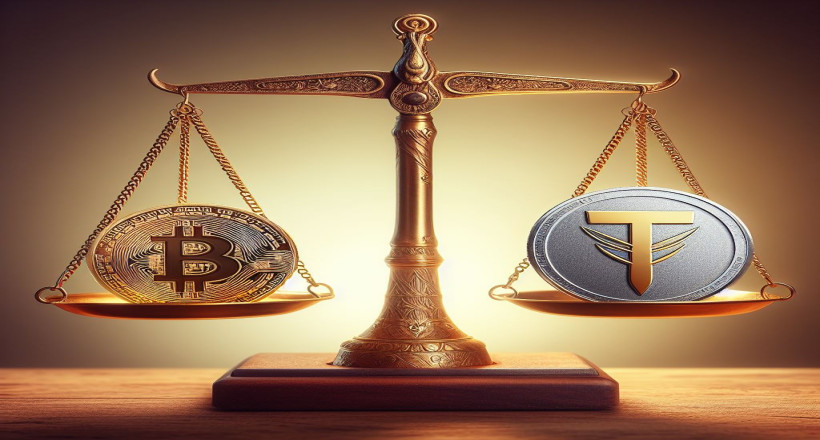
What Are Stablecoins?
Stablecoins are cryptocurrencies designed to maintain a stable value by being pegged or tied to the value of another asset such as a currency, commodity, or financial instrument. They serve as a solution to the high volatility experienced by many popular cryptocurrencies like Bitcoin (BTC), which hinders their suitability for everyday transactions.
Why Are Stablecoins So Important?
Bitcoin, the leading cryptocurrency, experiences significant price volatility, with its value fluctuating dramatically over short periods. Intraday price swings are also common, often exceeding 10% within hours.
While such volatility can benefit traders, it renders routine transactions risky for both buyers and sellers. Investors holding cryptocurrencies for long-term gains seek stability.
To function effectively as a medium of exchange, a currency must maintain relative stability, ensuring it retains purchasing power in the short term.
Stablecoins aim to address this volatility issue by stabilizing the value of the cryptocurrency through various means, hence providing a more reliable medium of exchange.
What Kinds of Stablecoins Are There?
The debate over stablecoins revolves around whether they are necessary given the widespread acceptance of traditional currencies like the U.S. dollar. However, many cryptocurrency supporters see them as pivotal in establishing decentralized digital currencies free from central bank influence. There are three main types of stablecoins categorized by their stabilization mechanisms: fiat-collateralized, crypto-collateralized, and algorithmic. Each type serves distinct purposes within the cryptocurrency ecosystem.
Fiat-Collateralized Stablecoins:
These stablecoins are backed by reserves of fiat currency, such as the U.S. dollar, ensuring their value stability.
Other collateral options may include precious metals like gold or commodities like crude oil, but most rely on U.S. dollar reserves.
Independent custodians maintain these reserves, which undergo regular audits to ensure transparency and trustworthiness.
Examples include Tether (USDT) and TrueUSD (TUSD), both pegged to the U.S. dollar at a 1:1 ratio.
Crypto-Collateralized Stablecoins:
Backed by reserves of other cryptocurrencies, rather than fiat currency, these stablecoins aim to maintain value stability.
Due to the volatility of the reserve cryptocurrencies, these stablecoins are overcollateralized, meaning the value of reserves exceeds the value of stablecoins issued.
A cryptocurrency worth $2 million might be held as reserve to issue $1 million in a crypto-backed stablecoin, insuring against a 50% decline in the price of the reserve cryptocurrency. MakerDAO's Dai (DAI) is a notable example, pegged to the U.S. dollar but backed by cryptocurrencies like Ethereum (ETH) and others, with reserves exceeding 150% of the circulating DAI stablecoin.
Algorithmic Stablecoins:
Stablecoin Regulation:
Regulators are closely examining stablecoins due to their rapid growth in the approximately $130 billion market and their potential impact on the wider financial system. In October 2021, the International Organization of Securities Commissions (IOSCO) stated that stablecoins should be regulated as part of financial market infrastructure, similar to payment systems and clearinghouses. The proposed regulations target stablecoins identified as systemically important by regulators, particularly those with the capacity to disrupt payment and settlement transactions.
What Is the Purpose of Stablecoin?
The purpose of stablecoins is to offer an alternative to the high volatility commonly associated with popular cryptocurrencies like Bitcoin (BTC). This volatility can make traditional cryptocurrencies less suitable for everyday transactions. By maintaining a stable value, stablecoins aim to provide a more reliable medium of exchange and store of value within the cryptocurrency ecosystem.
How Does Stablecoin Work?
Stablecoins operate by attempting to tie their market value to an external reference, typically a fiat currency. Unlike more volatile cryptocurrencies, stablecoins are designed to serve as more reliable mediums of exchange. They achieve this stability by pegging their value to a currency like the U.S. dollar or to the price of a commodity such as gold, or by utilizing algorithms to control their supply. Additionally, stablecoins often maintain reserve assets as collateral or use algorithmic formulas to manage their supply, further supporting their stability.
What is the best stablecoin?
The most well-known stablecoin in terms of market capitalization is Tether (USDT), which maintains a 1:1 relationship with the US dollar. The support of these reserves is gold. Tether is consistently ranked among the top cryptocurrencies by market capitalization and is readily available on major cryptocurrency exchanges such as BestChanger.com